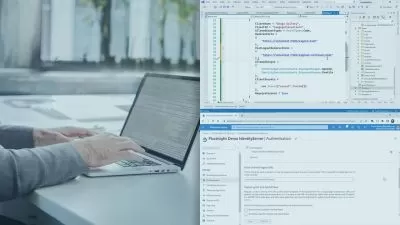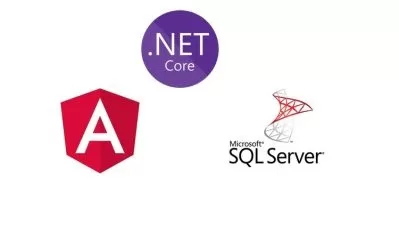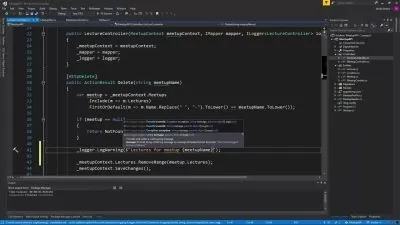ASP.NET Core in Action, Second Edition
Focused View
26:12:03
68 View
00001 Part 1. Getting started with ASP.NET Core.mp4
03:03
00002 Chapter 1. Getting started with ASP.NET Core.mp4
09:45
00003 Chapter 1. What is ASP.NET Core.mp4
09:15
00004 Chapter 1. If you re new to .NET development.mp4
06:17
00005 Chapter 1. If you re a .NET Framework developer creating a new application.mp4
10:34
00006 Chapter 1. Converting an existing ASP.NET application to ASP.NET Core.mp4
10:22
00007 Chapter 1. How does ASP.NET Core process a request.mp4
07:59
00008 Chapter 2. Your first application.mp4
08:52
00009 Chapter 2. Creating your first ASP.NET Core application.mp4
09:31
00010 Chapter 2. Running the web application.mp4
07:05
00011 Chapter 2. The .csproj project file - Defining your dependencies.mp4
11:57
00012 Chapter 2. The Startup class - Configuring your application.mp4
07:47
00013 Chapter 2. Defining how requests are handled with middleware.mp4
12:40
00014 Chapter 2. Handling request logic with PageModels and handlers.mp4
09:00
00015 Chapter 3. Handling requests with the middleware pipeline.mp4
13:54
00016 Chapter 3. Combining middleware in a pipeline.mp4
07:51
00017 Chapter 3. Simple pipeline scenario 2 - Handling static files.mp4
11:59
00018 Chapter 3. Handling errors using middleware.mp4
12:38
00019 Chapter 3. Handling other errors - StatusCodePagesMiddleware.mp4
09:29
00020 Chapter 4. Creating a website with Razor Pages.mp4
09:43
00021 Chapter 4. The MVC design pattern.mp4
06:34
00022 Chapter 4. Applying the MVC design pattern to Razor Pages.mp4
06:49
00023 Chapter 4. Applying the MVC design pattern to Razor Pages.mp4
12:37
00024 Chapter 4. Razor Pages vs. MVC in ASP.NET Core.mp4
10:22
00025 Chapter 4. When to choose MVC controllers over Razor Pages.mp4
11:48
00026 Chapter 4. Returning responses with ActionResults.mp4
09:38
00027 Chapter 5. Mapping URLs to Razor Pages using routing.mp4
08:33
00028 Chapter 5. Routing in ASP.NET Core.mp4
07:47
00029 Chapter 5. Convention-based routing vs. attribute routing.mp4
10:09
00030 Chapter 5. Customizing Razor Page route templates.mp4
09:39
00031 Chapter 5. Exploring the route template syntax.mp4
12:11
00032 Chapter 5. Generating URLs from route parameters.mp4
09:10
00033 Chapter 5. Generating URLs from other parts of your application.mp4
08:49
00034 Chapter 5. Customizing conventions with Razor Pages.mp4
08:59
00035 Chapter 6. The binding model - Retrieving and validating user input.mp4
09:59
00036 Chapter 6. From request to model - Making the request useful.mp4
07:57
00037 Chapter 6. Binding simple types.mp4
06:35
00038 Chapter 6. Binding complex types.mp4
09:46
00039 Chapter 6. Choosing a binding source.mp4
09:45
00040 Chapter 6. Using DataAnnotations attributes for validation.mp4
12:05
00041 Chapter 6. Validating on the client for user experience.mp4
10:16
00042 Chapter 7. Rendering HTML using Razor views.mp4
10:35
00043 Chapter 7. Creating Razor views.mp4
12:31
00044 Chapter 7. Creating dynamic web pages with Razor.mp4
10:51
00045 Chapter 7. Layouts partial views and ViewStart.mp4
08:04
00046 Chapter 7. Using partial views to encapsulate markup.mp4
11:24
00047 Chapter 7. Selecting a view from an MVC controller.mp4
11:08
00048 Chapter 8. Building forms with Tag Helpers.mp4
10:10
00049 Chapter 8. Creating forms using Tag Helpers.mp4
11:24
00050 Chapter 8. The Label Tag Helper.mp4
10:16
00051 Chapter 8. The Select Tag Helper.mp4
11:19
00052 Chapter 8. Generating links with the Anchor Tag Helper.mp4
06:47
00053 Chapter 8. Using conditional markup with the Environment Tag Helper.mp4
08:43
00054 Chapter 9. Creating a Web API for mobile and client applications using MVC.mp4
09:52
00055 Chapter 9. Creating your first Web API project.mp4
13:22
00056 Chapter 9. Applying the MVC design pattern to a Web API.mp4
07:05
00057 Chapter 9. Attribute routing - Linking action methods to URLs.mp4
11:35
00058 Chapter 9. Using common conventions with the ApiController attribute.mp4
07:45
00059 Chapter 9. Generating a response from a model.mp4
08:56
00060 Chapter 9. Choosing a response format with content negotiation.mp4
08:49
00061 Part 2. Building complete applications.mp4
02:50
00062 Chapter 10. Service configuration with dependency injection.mp4
07:10
00063 Chapter 10. Understanding the benefits of dependency injection.mp4
07:32
00064 Chapter 10. Creating loosely coupled code.mp4
06:13
00065 Vhapter 10. Using the dependency injection container.mp4
08:16
00066 Chapter 10. Registering services using objects and lambdas.mp4
12:32
00067 Chapter 10. Injecting services into action methods page handlers and views.mp4
06:39
00068 Chapter 10. Understanding lifetimes - When are services created.mp4
08:45
00069 Chapter 10. Singleton - There can be only one.mp4
10:29
00070 Chapter 11. Configuring an ASP.NET Core application.mp4
09:37
00071 Chapter 11. Building a configuration object for your app.mp4
10:33
00072 Chapter 11. Using multiple providers to override configuration values.mp4
07:10
00073 Chapter 11. Storing configuration secrets safely.mp4
07:04
00074 Chapter 11. Using strongly typed settings with the options pattern.mp4
07:02
00075 Chapter 11. Reloading strongly typed options with IOptionsSnapshot.mp4
08:16
00076 Chapter 11. Configuring an application for multiple environments.mp4
08:47
00077 Chapter 11. Setting the hosting environment.mp4
09:18
00078 Chapter 12. Saving data with Entity Framework Core.mp4
13:05
00079 Chapter 12. When should you choose EF Core.mp4
08:30
00080 Chapter 12. Adding EF Core to an application.mp4
13:34
00081 Chapter 12. Managing changes with migrations.mp4
12:28
00082 Chapter 12. Querying data from and saving data to the database.mp4
09:34
00083 Chapter 12. Loading a single record.mp4
09:48
00084 Chapter 12. Using EF Core in production applications.mp4
09:57
00085 Chapter 13. The MVC and Razor Pages filter pipeline.mp4
09:51
00086 Chapter 13. The Razor Pages filter pipeline.mp4
12:17
00087 Chapter 13. Adding filters to your actions controllers Razor Pages and globally.mp4
08:51
00088 Chapter 13. Creating custom filters for your application.mp4
09:59
00089 Chapter 13. Action filters - Customizing model binding and action results.mp4
09:14
00090 Chapter 13. Exception filters - Custom exception handling for your action methods.mp4
10:49
00091 Chapter 13. Page filters - Customizing model binding for Razor Pages.mp4
06:52
00092 Chapter 13. Using dependency injection with filter attributes.mp4
10:33
00093 Chapter 14. Authentication - Adding users to your application with Identity.mp4
08:30
00094 Chapter 14. Authentication in ASP.NET Core - Services and middleware.mp4
06:51
00095 Chapter 14. Authentication for APIs and distributed applications.mp4
07:22
00096 Chapter 14. What is ASP.NET Core Identity.mp4
06:45
00097 Chapter 14. Creating a project that uses ASP.NET Core Identity.mp4
08:33
00098 Chapter 14. The ASP.NET Core Identity data model.mp4
10:06
00099 Chapter 14. Adding ASP.NET Core Identity to an existing project.mp4
08:34
00100 Chapter 14. Customizing a page in ASP.NET Core Identity s default UI.mp4
07:18
00101 Chapter 14. Managing users - Adding custom data to users.mp4
10:12
00102 Chapter 15. Authorization - Securing your application.mp4
09:50
00103 Chapter 15. Authorization in ASP.NET Core.mp4
08:32
00104 Chapter 15. Handling unauthorized requests.mp4
12:26
00105 Chapter 15. Creating custom policies for authorization.mp4
14:29
00106 Chapter 15. Controlling access with resource-based authorization.mp4
12:49
00107 Chapter 15. Hiding elements in Razor templates from unauthorized users.mp4
08:37
00108 Chapter 16. Publishing and deploying your application.mp4
08:13
00109 Chapter 16. Running vs. publishing an ASP.NET Core app.mp4
11:55
00110 Chapter 16. Publishing your app to IIS.mp4
13:02
00111 Chapter 16. Hosting an application on Linux.mp4
07:16
00112 Chapter 16. Preparing your app for deployment to Linux.mp4
05:50
00113 Chapter 16. Configuring the URLs for your application.mp4
06:56
00114 Chapter 16. Optimizing your client-side assets using BundlerMinifier.mp4
10:25
00115 Chapter 16. Adding BundlerMinifier to your application.mp4
06:44
00116 Chapter 16. Serving common files from a CDN.mp4
08:08
00117 Part 3. Extending your applications.mp4
04:02
00118 Chapter 17. Monitoring and troubleshooting errors with logging This chapter covers.mp4
11:40
00119 Chapter 17. Adding log messages to your application.mp4
09:19
00120 Chapter 17. Log category - Which component created the log.mp4
10:19
00121 Chapter 17. Adding a new logging provider to your application.mp4
11:07
00122 Chapter 17. Changing log verbosity with filtering.mp4
07:46
00123 Chapter 17. Structured logging - Creating searchable useful logs.mp4
08:31
00124 Chapter 17. Using scopes to add additional properties to your logs.mp4
06:36
00125 Chapter 18. Improving your application s security.mp4
11:03
00126 Chapter 18. Using the ASP.NET Core HTTPS development certificates.mp4
09:28
00127 Chapter 18. Enforcing HTTPS for your whole app.mp4
11:23
00128 Chapter 18. Defending against cross-site scripting XSS attacks.mp4
06:22
00129 Chapter 18. Protecting from cross-site request forgery CSRF attacks.mp4
11:37
00130 Chapter 18. Protecting from cross-site request forgery CSRF attacks.mp4
09:48
00131 Chapter 18. Adding CORS to specific Web API actions with EnableCorsAttribute.mp4
09:19
00132 Chapter 18. Avoiding SQL injection attacks with EF Core and parameterization.mp4
07:01
00133 Chapter 18. Protecting your users passwords and data.mp4
09:43
00134 Chapter 19. Using a third-party dependency injection container.mp4
11:22
00135 Chapter 19. Building custom components.mp4
09:08
00136 Chapter 19. Branching middleware pipelines with the Map extension.mp4
10:44
00137 Chapter 19. Building a custom middleware component.mp4
11:11
00138 Chapter 19. Creating simple endpoints with MapGet and WriteJsonAsync.mp4
08:36
00139 Chapter 19. Handling complex configuration requirements.mp4
11:34
00140 Chapter 20. Building custom MVC and Razor Pages components.mp4
11:17
00141 Chapter 20. Creating a custom Tag Helper to conditionally hide elements.mp4
07:08
00142 Chapter 20. View components - Adding logic to partial views.mp4
10:48
00143 Chapter 20. Building a custom validation attribute.mp4
08:06
00144 Chapter 20. Replacing the validation framework with FluentValidation.mp4
08:22
00145 Chapter 20. Adding FluentValidation to your application.mp4
08:21
00146 Chapter 21. Calling remote APIs with IHttpClientFactory.mp4
12:32
00147 Chapter 21. Creating HttpClients with IHttpClientFactory.mp4
08:06
00148 Chapter 21. Configuring named clients at registration time.mp4
12:09
00149 Chapter 21. Creating a custom HttpMessageHandler.mp4
08:37
00150 Chapter 22. Building background tasks and services.mp4
13:28
00151 Chapter 22. Creating headless worker services using IHost.mp4
13:59
00152 Chapter 22. Coordinating background tasks using Quartz.NET.mp4
11:43
00153 Chapter 22. Using clustering to add redundancy to your background tasks.mp4
10:29
00154 Chapter 23. Testing your application.mp4
10:27
00155 Chapter 23. Unit testing with xUnit.mp4
10:29
00156 Chapter 23. Adding Fact and Theory unit tests.mp4
07:56
00157 Chapter 23. Unit testing custom middleware.mp4
12:34
00158 Chapter 23. Integration testing - Testing your whole app in-memory.mp4
06:24
00159 Chapter 23. Replacing dependencies in WebApplicationFactory.mp4
06:24
00160 Chapter 23. Isolating the database with an in-memory EF Core provider.mp4
13:13
00161 Appendix A. Preparing your development environment.mp4
11:25
00162 Appendix B. Sharing code between projects.mp4
12:15
00163 Appendix B. Understanding the .NET ecosystem.mp4
09:43
00164 Appendix B. NET 5.0 - The first step in the One .NET vision.mp4
06:24
00165 Appendix B. Fudging .NET Standard 2.0 support with the compatibility shim.mp4
09:22
More details
User Reviews
Rating
average 0
Focused display
Category

Manning Publications
View courses Manning PublicationsManning Publications is an American publisher specializing in content relating to computers. Manning mainly publishes textbooks but also release videos and projects for professionals within the computing world.
- language english
- Training sessions 165
- duration 26:12:03
- Release Date 2023/11/06









